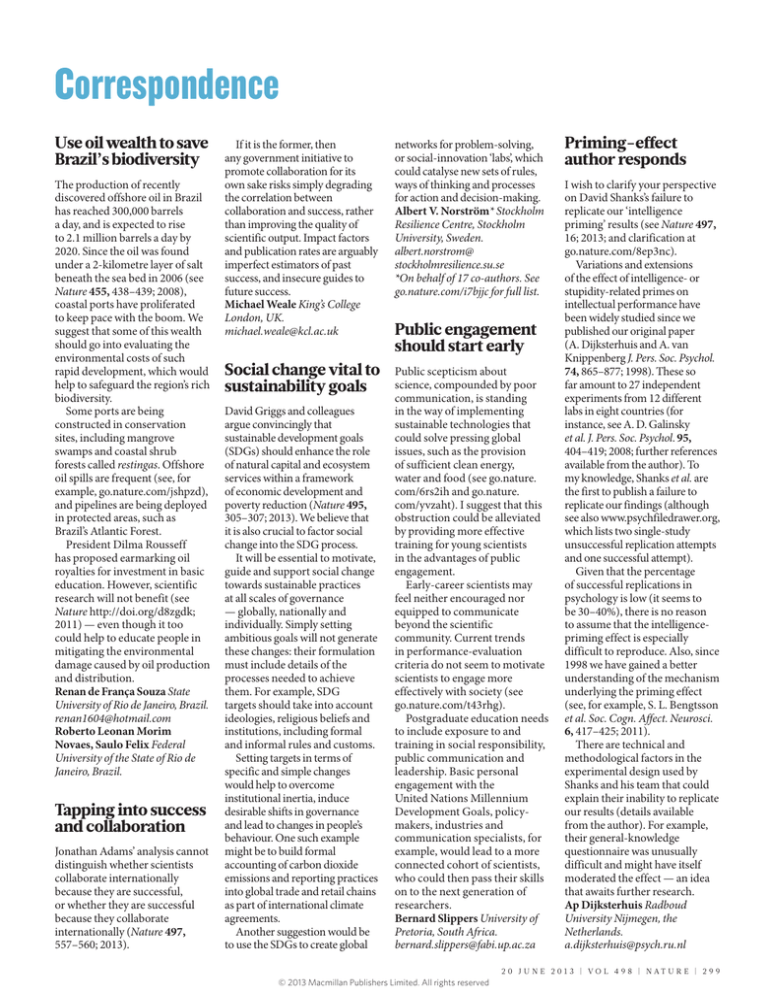
Correspondence
Use oil wealth to save
Brazil’s biodiversity
The production of recently
discovered offshore oil in Brazil
has reached 300,000 barrels
a day, and is expected to rise
to 2.1 million barrels a day by
2020. Since the oil was found
under a 2-kilometre layer of salt
beneath the sea bed in 2006 (see
Nature 455, 438–439; 2008),
coastal ports have proliferated
to keep pace with the boom. We
suggest that some of this wealth
should go into evaluating the
environmental costs of such
rapid development, which would
help to safeguard the region’s rich
biodiversity.
Some ports are being
constructed in conservation
sites, including mangrove
swamps and coastal shrub
forests called restingas. Offshore
oil spills are frequent (see, for
example, go.nature.com/jshpzd),
and pipelines are being deployed
in protected areas, such as
Brazil’s Atlantic Forest.
President Dilma Rousseff
has proposed earmarking oil
royalties for investment in basic
education. However, scientific
research will not benefit (see
Nature http://doi.org/d8zgdk;
2011) — even though it too
could help to educate people in
mitigating the environmental
damage caused by oil production
and distribution.
Renan de França Souza State
University of Rio de Janeiro, Brazil.
renan1604@hotmail.com
Roberto Leonan Morim
Novaes, Saulo Felix Federal
University of the State of Rio de
Janeiro, Brazil.
Tapping into success
and collaboration
Jonathan Adams’ analysis cannot
distinguish whether scientists
collaborate internationally
because they are successful,
or whether they are successful
because they collaborate
internationally (Nature 497,
557–560; 2013).
If it is the former, then
any government initiative to
promote collaboration for its
own sake risks simply degrading
the correlation between
collaboration and success, rather
than improving the quality of
scientific output. Impact factors
and publication rates are arguably
imperfect estimators of past
success, and insecure guides to
future success.
Michael Weale King’s College
London, UK.
michael.weale@kcl.ac.uk
networks for problem-solving,
or social-innovation ‘labs’, which
could catalyse new sets of rules,
ways of thinking and processes
for action and decision-making.
Albert V. Norström* Stockholm
Resilience Centre, Stockholm
University, Sweden.
albert.norstrom@
stockholmresilience.su.se
*On behalf of 17 co-authors. See
go.nature.com/i7bjjc for full list.
Social change vital to
sustainability goals
Public scepticism about
science, compounded by poor
communication, is standing
in the way of implementing
sustainable technologies that
could solve pressing global
issues, such as the provision
of sufficient clean energy,
water and food (see go.nature.
com/6rs2ih and go.nature.
com/yvzaht). I suggest that this
obstruction could be alleviated
by providing more effective
training for young scientists
in the advantages of public
engagement.
Early-career scientists may
feel neither encouraged nor
equipped to communicate
beyond the scientific
community. Current trends
in performance-evaluation
criteria do not seem to motivate
scientists to engage more
effectively with society (see
go.nature.com/t43rhg).
Postgraduate education needs
to include exposure to and
training in social responsibility,
public communication and
leadership. Basic personal
engagement with the
United Nations Millennium
Development Goals, policymakers, industries and
communication specialists, for
example, would lead to a more
connected cohort of scientists,
who could then pass their skills
on to the next generation of
researchers.
Bernard Slippers University of
Pretoria, South Africa.
bernard.slippers@fabi.up.ac.za
David Griggs and colleagues
argue convincingly that
sustainable development goals
(SDGs) should enhance the role
of natural capital and ecosystem
services within a framework
of economic development and
poverty reduction (Nature 495,
305–307; 2013). We believe that
it is also crucial to factor social
change into the SDG process.
It will be essential to motivate,
guide and support social change
towards sustainable practices
at all scales of governance
— globally, nationally and
individually. Simply setting
ambitious goals will not generate
these changes: their formulation
must include details of the
processes needed to achieve
them. For example, SDG
targets should take into account
ideologies, religious beliefs and
institutions, including formal
and informal rules and customs.
Setting targets in terms of
specific and simple changes
would help to overcome
institutional inertia, induce
desirable shifts in governance
and lead to changes in people’s
behaviour. One such example
might be to build formal
accounting of carbon dioxide
emissions and reporting practices
into global trade and retail chains
as part of international climate
agreements.
Another suggestion would be
to use the SDGs to create global
Public engagement
should start early
Priming-effect
author responds
I wish to clarify your perspective
on David Shanks’s failure to
replicate our ‘intelligence
priming’ results (see Nature 497,
16; 2013; and clarification at
go.nature.com/8ep3nc).
Variations and extensions
of the effect of intelligence- or
stupidity-related primes on
intellectual performance have
been widely studied since we
published our original paper
(A. Dijksterhuis and A. van
Knippenberg J. Pers. Soc. Psychol.
74, 865–877; 1998). These so
far amount to 27 independent
experiments from 12 different
labs in eight countries (for
instance, see A. D. Galinsky
et al. J. Pers. Soc. Psychol. 95,
404–419; 2008; further references
available from the author). To
my knowledge, Shanks et al. are
the first to publish a failure to
replicate our findings (although
see also www.psychfiledrawer.org,
which lists two single-study
unsuccessful replication attempts
and one successful attempt).
Given that the percentage
of successful replications in
psychology is low (it seems to
be 30–40%), there is no reason
to assume that the intelligencepriming effect is especially
difficult to reproduce. Also, since
1998 we have gained a better
understanding of the mechanism
underlying the priming effect
(see, for example, S. L. Bengtsson
et al. Soc. Cogn. Affect. Neurosci.
6, 417–425; 2011).
There are technical and
methodological factors in the
experimental design used by
Shanks and his team that could
explain their inability to replicate
our results (details available
from the author). For example,
their general-knowledge
questionnaire was unusually
difficult and might have itself
moderated the effect — an idea
that awaits further research.
Ap Dijksterhuis Radboud
University Nijmegen, the
Netherlands.
a.dijksterhuis@psych.ru.nl
2 0 J U N E 2 0 1 3 | VO L 4 9 8 | NAT U R E | 2 9 9
© 2013 Macmillan Publishers Limited. All rights reserved





